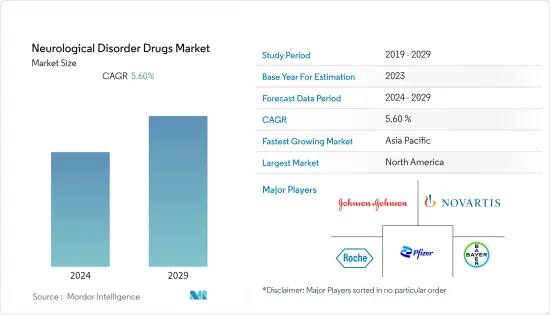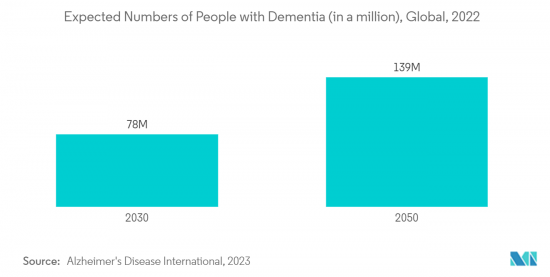 |
市場調査レポート
商品コード
1408259
神経疾患治療薬の市場シェア分析、産業動向と統計、2024~2029年の成長予測Neurological Disorder Drugs - Market Share Analysis, Industry Trends & Statistics, Growth Forecasts 2024 - 2029 |
||||||
● お客様のご希望に応じて、既存データの加工や未掲載情報(例:国別セグメント)の追加などの対応が可能です。 詳細はお問い合わせください。
| 神経疾患治療薬の市場シェア分析、産業動向と統計、2024~2029年の成長予測 |
|
出版日: 2024年01月04日
発行: Mordor Intelligence
ページ情報: 英文 111 Pages
納期: 2~3営業日
|
- 全表示
- 概要
- 目次
神経疾患治療薬市場は予測期間中にCAGR 5.6%を記録すると予測されます。

COVID-19パンデミックは、パンデミックの初期段階において、世界中の患者に対する神経医療サービスの進展を妨げました。しかし、政府の取り組みにより治療は再開されました。COVID後は、より多くの神経学的ケアが求められるようになったため、メンタルヘルス、うつ病、不安症への注目が高まった。例えば、Frontiers in Psychiatry誌が2022年8月に発表した論文によると、米国ではCOVID-19に罹患した後、約18.4%の人が中等度から重度のうつ病を経験したといいます。同様に、2023年3月のKFF/CNNの調査によると、不安や抑うつの症状は、2023年2月の男性の28%に比べて女性の36%で増加しています。また、同じ情報源によると、2021年には、メンタルヘルスと薬物使用障害の外来受診の40%近くが遠隔医療を通じて行われたといいます。したがって、パンデミックは人々の神経障害の増加につながり、市場成長に大きな影響を与えました。
市場成長を促進すると予想される要因には、神経疾患の有病率の増加、疾患の早期診断に対する意識の高まり、神経疾患に対する研究開発の増加などがあります。世界中で、神経疾患は障害や死亡の主要原因となっています。アルツハイマー病(AD)、パーキンソン病(PD)、筋萎縮性側索硬化症(ALS)などの神経変性疾患は、世界中の高齢者集団に重大な罹患率と死亡率をもたらしています。世界中の多くの組織が、神経疾患の発生率を減らすために実質的な対策を講じています。例えば、2022年4月に発表されたWHOの報告書によると、てんかんとその他の神経疾患に関する分野横断的な世界行動計画(2022~2031年)は、パンデミック全体とパンデミック後の神経疾患の負担に対処する前例のない機会となります。これにより、神経疾患治療薬に対する高い需要が見込まれます。このような神経疾患の減少に向けた取り組みが、予測期間中の市場を牽引すると予想されます。
認知症、自閉症、アルツハイマー病、その他の希少疾患などの神経疾患の有病率の高さから、神経治療薬の市場は上昇すると予測されています。例えば、WHOが2023年4月に発表したデータによると、世界の認知症患者は約5,500万人で、2030年には7,800万人、2050年には1億3,900万人に増加すると見られています。WHOはまた、認知症の世界の経済的負担は2019年には1兆3,000億米ドルと推定され、2030年には2兆8,000億米ドルに上昇する見込みであると述べています。このため、予測期間中の市場成長に寄与すると予測されます。
さらに、アルツハイマー病の広範な研究開発も市場成長に寄与すると予測されます。例えば、2022年5月にAlzheimer's Associationが発表した記事によると、2022年1月25日現在、ADを対象とした172の臨床試験で143の薬剤が開発されています。パイプラインの内訳は、フェーズ3が47試験で31薬剤、フェーズ2が94試験で82薬剤、フェーズ1が31試験で30薬剤となっています。薬剤デザイン、アウトカム評価、バイオマーカーの使用、臨床試験の実施における進歩により、アルツハイマー病患者に対するより良い新しい治療法の提供が加速されることが期待されます。このような研究開発の取り組みにより、神経疾患治療薬市場の拡大が期待されます。神経疾患に対する医薬品の承認もまた、市場の成長を促進する可能性が高いです。例えば、2023年5月、Biophore India Pharmaceuticalsは、インドで神経疾患用のカンナビジオール溶液100mg/mlを製造・販売する承認を中央医薬品標準管理機構(CDSCO)から取得したと発表しました。
しかし、神経疾患治療薬に関連する厳しい規制だけでなく、診断や治療にかかる高額な費用が、予測期間中の市場の成長を抑制すると予想されます。
神経疾患治療薬の市場動向
アルツハイマー病セグメントは予測期間中、神経疾患治療薬市場で大きなシェアを占めると予想される
アルツハイマー病は、世界人口の高齢化に伴い、より一般的な疾患となっており、この疾患の発生率を高め、アルツハイマー病治療薬市場の成長機会を提供しています。例えば、Alzheimer's Disease Facts And Figures 2023レポートによると、65歳以上のアメリカ人は2021年の5,800万人から2050年には8,800万人に増加すると予測されています。また、上記の情報源によれば、2023年には約240万人のアルツハイマー型認知症患者が85歳以上になる可能性があり、アルツハイマー型認知症患者全体の33%を占めると予測されています。この数は2060年には670万人に達し、65歳以上のアルツハイマー型認知症患者の約48%を占めると予測されています。認知症のリスクは加齢とともに上昇するため、アルツハイマー型認知症やその他の認知症を患う人の数や割合は今後増加すると予想され、高度な治療に対する需要が生まれ、市場の成長を後押しすると予測されています。
また、アルツハイマー病治療のための様々な薬剤が開発中であり、間もなく発売されると予測されているため、予測期間中の市場成長に寄与すると思われます。例えば、2023年1月には、早期承認プロセスを通じて、Leqembi(lecanemab-irmb)がアルツハイマー病治療薬として米国食品医薬品局(FDA)の承認を取得しました。eqembiは、アルツハイマー病の基本的な病態に対処する新規承認クラスの2番目の薬剤です。同様に、2023年5月、米国FDAはRexulti(brexpiprazole)経口錠をアルツハイマー病による認知症に伴う興奮の治療薬として追加承認しました。このような神経系薬剤の承認は、市場の成長を加速させると予想されます。

予測期間中、北米が大きなシェアを占める見込み
北米は、さまざまな承認、提携、買収、同地域における神経疾患の増加により、世界の神経疾患治療薬市場で最大のシェアを占めると予測されます。
様々な神経障害の発生件数の増加が、市場成長を促進すると予想される顕著な理由です。例えば、パーキンソン病財団の2023年のデータによると、米国ではほぼ100万人がパーキンソン病(PD)を患っており、2030年までにその数は120万人に達すると予想されています。また、パーキンソン病はアルツハイマー病に次いで多い神経変性疾患です。したがって、パーキンソン病の大きな負担は予測期間中の市場成長に寄与すると思われます。
米国における新製品開発、承認、提携、買収などの戦略的活動が神経疾患治療薬市場の成長を促進しています。例えば、2023年3月、Pfizer Inc.は、成人の前兆を伴うまたは伴わない片頭痛の即時治療のためのカルシトニン遺伝子関連ペプチド(CGRP)受容体拮抗点鼻薬ZAVZPRETTM(zavegepant)が米国FDAから承認を取得したと発表しました。このように、同国での製品承認は市場の成長を促進すると予想されます。
神経疾患治療薬業界概要
神経疾患治療薬市場は細分化され、競合が激しく、複数の大手企業で構成されています。競合情勢には、Merck &Co., Inc.、AstraZeneca、Abbott、F. Hoffmann-La Roche Ltd.、Novartis AGなど、市場シェアを持ち知名度の高い国際企業や地元企業の分析が含まれます。
その他の特典:
- エクセル形式の市場予測(ME)シート
- 3ヶ月間のアナリストサポート
目次
第1章 イントロダクション
- 調査の前提条件と市場定義
- 調査範囲
第2章 調査手法
第3章 エグゼクティブサマリー
第4章 市場力学
- 市場概要
- 市場促進要因
- 神経疾患の高い有病率
- 疾患の早期診断に対する意識の高まり
- 神経疾患の研究開発の増加
- 市場抑制要因
- 診断と治療にかかるコストの高さ
- 神経疾患治療薬に関する厳しい規制
- ポーターのファイブフォース分析
- 新規参入業者の脅威
- 買い手/消費者の交渉力
- 供給企業の交渉力
- 代替品の脅威
- 競争企業間の敵対関係の強さ
第5章 市場セグメンテーション(市場規模-100万米ドル)
- 疾患別
- てんかん
- アルツハイマー病
- パーキンソン病
- 多発性硬化症
- 脳血管疾患
- その他の疾患
- 薬剤タイプ別
- コリンエステラーゼ阻害薬
- NMDA受容体拮抗薬
- 抗てんかん薬
- 抗精神病薬と抗うつ薬
- その他の薬物タイプ
- 流通チャネル別
- 病院薬局
- オンライン薬局
- 小売薬局
- 地域別
- 北米
- 米国
- カナダ
- メキシコ
- 欧州
- ドイツ
- 英国
- フランス
- イタリア
- スペイン
- その他の欧州
- アジア太平洋
- 中国
- 日本
- インド
- オーストラリア
- 韓国
- その他のアジア太平洋
- 中東・アフリカ
- GCC諸国
- 南アフリカ
- その他の中東・アフリカ
- 南米
- ブラジル
- アルゼンチン
- その他の南米
- 北米
第6章 競合情勢
- 企業プロファイル
- Merck & Co.,Inc
- AstraZeneca
- Abbott
- F. Hoffmann-La Roche Ltd.
- Novartis AG
- Pfizer Inc.
- Sanofi
- Bayer AG
- Johnson & Johnson Private Limited
- Teva Pharmaceutical Industries Ltd.
第7章 市場機会と今後の動向

The Neurological Disorder Drugs Market is expected to register a CAGR of 5.6% during the forecast period.
The COVID-19 pandemic hampered the progress of neurological healthcare services for patients worldwide in the initial phases of the pandemic. However, treatment resumed following government initiatives. The focus on mental health, depression, and anxiety increased post-COVID as it demanded more neurological care. For instance, an article published by Frontiers in Psychiatry in August 2022 stated that around 18.4% of people in the United States experienced moderate to severe depression after suffering from COVID-19 disease. Similarly, according to a KFF/CNN survey of March 2023, symptoms of anxiety and depression elevated among women, which is 36% compared to men's at 28% in February 2023. The same source also stated that nearly 40% of all mental health and substance use disorder outpatient visits were delivered through telehealth in 2021. Hence, the pandemic led to an increase in neurological disorders among people, which significantly had a significant impact on market growth.
The factors expected to drive the market growth include the increasing prevalence of neurological diseases, rising awareness for early disease diagnosis, and increasing R&D for neurological disorders. Worldwide, neurological illnesses are a leading cause of disability and mortality. Neurodegenerative disorders such as Alzheimer's disease (AD), Parkinson's disease (PD), and amyotrophic lateral sclerosis (ALS) cause significant morbidity and mortality in the aged population worldwide. Many organizations across the globe are taking substantial steps to reduce the incidence of neurological diseases. For instance, according to the WHO report published in April 2022, the intersectoral global action plan on epilepsy and other neurological disorders 2022-2031 represents an unprecedented opportunity to address the burden of neurological illnesses throughout and after the pandemic. This is expected to create a high demand for neurological drugs. Such initiatives to reduce neurological disorders are expected to drive the market during the forecast period.
The market for neurological drugs is predicted to rise due to the high prevalence of neurological illnesses such as dementia, autism, Alzheimer's disease, and other rare diseases. For instance, according to the WHO's data published in April 2023, about 55 million people worldwide have dementia, and this is likely to rise to 78 million by 2030 and 139 million by 2050. The WHO also stated that the global financial burden of dementia was estimated to be USD 1.3 trillion in 2019 and is expected to climb to USD 2.8 trillion by 2030. Thus, this is projected to contribute to the market growth over the forecast period.
Furthermore, extensive research and developments for Alzheimer's are also projected to contribute to the market growth. For instance, an article published by Alzheimer's Association in May 2022 stated that as of January 25, 2022, there were 143 agents in 172 clinical trials for AD. The pipeline included 31 agents in 47 trials in Phase 3, 82 agents in 94 trials in Phase 2, and 30 agents in 31 trials in Phase 1. Advances in drug design, outcome measures, use of biomarkers, and trial conduct promise to accelerate the delivery of new and better treatments for patients with Alzheimer's. Such R&D initiatives are expected to boost the market for neurological drugs. Drug approvals for neurological disorders are also likely to drive market growth. For instance, in May 2023, Biophore India Pharmaceuticals announced that it had received approval from the Central Drugs Standard Control Organisation (CDSCO) to manufacture and market Cannabidiol Solution 100mg/ml for neuro disorders in India.
However, the high cost of diagnosis and treatment as well as stringent regulations associated with the neurological drugs is expected to restrain the market's growth over the forecast period.
Neurological Disorder Drugs Market Trends
The Alzheimer's Disease Segment is Expected to Hold a Significant Share in the Neurological Disorders Drugs Market Over the Forecast Period
Alzheimer's disease is becoming more common as the global population ages, which increases the disease's incidence and provides opportunities for growth in the market for Alzheimer's treatment. For instance, as per the Alzheimer's Disease Facts And Figures 2023 report, Americans aged 65 years and older are projected to grow from 58 million in 2021 to 88 million by 2050. The above source also stated that in 2023 about 2.4 million people with Alzheimer's dementia are likely to be 85 years of age or older and are projected to account for 33% of all people with Alzheimer's dementia. This number is projected to reach 6.7 million people by 2060, accounting for about 48% of all people 65 years and older with Alzheimer's dementia. As the risk of dementia rises with age, it is anticipated that the number and percentage of people with Alzheimer's or other dementias will likely increase in the coming years, which is projected to create demand for advanced treatment, thereby boosting the market growth.
Besides, various medications for Alzheimer's therapy are in development and are projected to launch shortly, which is likely to contribute to the market growth over the forecast period. For instance, in January 2023, through the Accelerated Approval process, Leqembi (lecanemab-irmb) received United States Food and Drug Administration (FDA) approval to treat Alzheimer's disease. eqembi is the second drug in a newly approved class of Alzheimer's disease that addresses the illness's basic pathogenesis. Similarly, in May 2023, the United States FDA granted the supplemental approval of Rexulti (brexpiprazole) oral tablets for treating agitation associated with dementia due to Alzheimer's disease. Such approvals for neurological drugs are expected to accelerate market growth.

North America is Expected to Hold a Significant Share Over the Forecast Period
North America is projected to account for the largest share of the global neurological disorder drugs market due to various approvals, collaborations, acquisitions, and increasing neurological disorders in the region.
Increasing incidences of various neurological disorders are the prominent reason expected to drive market growth. For instance, according to the Parkinson's Disease Foundation's data from 2023, in the United States, almost a million people have Parkinson's disease (PD), and by 2030, the number is expected to reach 1.2 million. Also, Parkinson's disease is the most common neurodegenerative condition after Alzheimer's disease. Hence, the huge burden of PD is likely to contribute to the market growth over the forecast Period.
Strategic activities such as new product development, approvals, collaborations, and acquisitions in the United States are driving the growth of the neurological disorder drugs market. For instance, in March 2023, Pfizer Inc. announced that ZAVZPRETTM (zavegepant), the calcitonin gene-related peptide (CGRP) receptor antagonist nasal spray for the immediate treatment of migraine with or without aura in adults, has received approval from the United States FDA. Thus, product approvals in the country are anticipated to drive the market's growth.
Neurological Disorder Drugs Industry Overview
The neurological disorder drugs market is fragmented, competitive and consists of several major players. The competitive landscape includes an analysis of a few international and local companies that hold market shares and are well-known including Merck & Co., Inc, AstraZeneca, Abbott, F. Hoffmann-La Roche Ltd., and Novartis AG.
Additional Benefits:
- The market estimate (ME) sheet in Excel format
- 3 months of analyst support
TABLE OF CONTENTS
1 INTRODUCTION
- 1.1 Study Assumptions and Market Definition
- 1.2 Scope of the Study
2 RESEARCH METHODOLOGY
3 EXECUTIVE SUMMARY
4 MARKET DYNAMICS
- 4.1 Market Overview
- 4.2 Market Drivers
- 4.2.1 High Prevalence of Neurological Diseases
- 4.2.2 Rising Awareness for Early Disease Diagnosis
- 4.2.3 Increasing Number of Research and Development for Neurological Diseases
- 4.3 Market Restraints
- 4.3.1 High Cost for Diagnosis and Treatment
- 4.3.2 Stringent Regulations Associated with the Neurological Drugs
- 4.4 Porter's Five Force Analysis
- 4.4.1 Threat of New Entrants
- 4.4.2 Bargaining Power of Buyers/Consumers
- 4.4.3 Bargaining Power of Suppliers
- 4.4.4 Threat of Substitute Products
- 4.4.5 Intensity of Competitive Rivalry
5 MARKET SEGMENTATION (Market Size by Value - USD Million)
- 5.1 By Disorders
- 5.1.1 Epilepsy
- 5.1.2 Alzheimer's Disease
- 5.1.3 Parkinson's Disease
- 5.1.4 Multiple Sclerosis
- 5.1.5 Cerebrovascular Disease
- 5.1.6 Other Disorders
- 5.2 By Drug Type
- 5.2.1 Cholinesterase Inhibitors
- 5.2.2 NMDA Receptor Antagonists
- 5.2.3 Antiepileptic
- 5.2.4 Antipsychotic and Antidepressant
- 5.2.5 Other Drugs Type
- 5.3 By Distribution Channels
- 5.3.1 Hospital Pharmacies
- 5.3.2 Online Pharmacies
- 5.3.3 Retail Pharmacies
- 5.4 Geography
- 5.4.1 North America
- 5.4.1.1 United States
- 5.4.1.2 Canada
- 5.4.1.3 Mexico
- 5.4.2 Europe
- 5.4.2.1 Germany
- 5.4.2.2 United Kingdom
- 5.4.2.3 France
- 5.4.2.4 Italy
- 5.4.2.5 Spain
- 5.4.2.6 Rest of Europe
- 5.4.3 Asia-Pacific
- 5.4.3.1 China
- 5.4.3.2 Japan
- 5.4.3.3 India
- 5.4.3.4 Australia
- 5.4.3.5 South Korea
- 5.4.3.6 Rest of Asia-Pacific
- 5.4.4 Middle East and Africa
- 5.4.4.1 GCC
- 5.4.4.2 South Africa
- 5.4.4.3 Rest of Middle East and Africa
- 5.4.5 South America
- 5.4.5.1 Brazil
- 5.4.5.2 Argentina
- 5.4.5.3 Rest of South America
- 5.4.1 North America
6 COMPETITIVE LANDSCAPE
- 6.1 Company Profiles
- 6.1.1 Merck & Co.,Inc
- 6.1.2 AstraZeneca
- 6.1.3 Abbott
- 6.1.4 F. Hoffmann-La Roche Ltd.
- 6.1.5 Novartis AG
- 6.1.6 Pfizer Inc.
- 6.1.7 Sanofi
- 6.1.8 Bayer AG
- 6.1.9 Johnson & Johnson Private Limited
- 6.1.10 Teva Pharmaceutical Industries Ltd.
